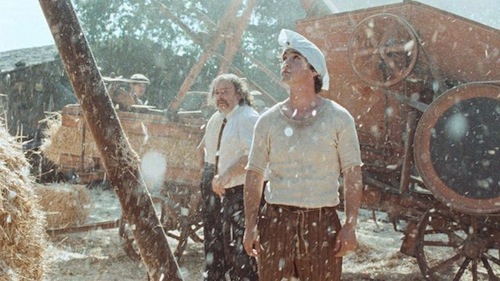Directed by Alice Rohrwacher
Country: Italy
Alice Rohrwacher keeps up the remarkable directorial career initiated in 2011 with Corpo Celeste and followed by The Wonders in 2014. Communicating with a superbly controlled cinematic language, the Italian director conjures up a surreal folktale in her third feature, Happy As Lazzaro, in which tradition and contemporaneity splice together with tribulation and grief.
Written in a somewhat prophetic way and told with a Visconti-like conviction, the film depicts the methodical life and daily struggles of the few naive sharecroppers that inhabit Inviolata, a mountainous off-the-beaten-track village. Among the youngest natives are Lazzaro (Adriano Tardiolo) and Antonia (director’s sister Alba Rohrwacher). The former, a pure-hearted young man who never complains about anything, is constantly solicited by those who need help, while the latter was selected to be the servant of the Marquise Alfonsina de Luna (Nicoletta Braschi), queen of cigarettes and wealthy proprietor of the local estate.
Shamefully, the Marquise exploits the villagers with the help of Nicola (Natalino Balasso), a tricky trader, who devours the bread and wine of the humble locals without giving them a cent in exchange. If anyone gets pretty bored around there, that person is Tancredi (Luca Chikovani), the Marquise’s rebellious son, who calls his mother a torturer. He forges an unlikely friendship with Lazzaro at the same time that simulates his own kidnapping.
Leaving the village is considered disrespect to the family and requires the Marquise's consent, but when Lazzaro wakes up from a long sleep, which epitomizes his own death, he finds no one but two burglars in the Marquise’s now decrepit house. One of the men is Pippo, Antonia’s son, but he is grown up and unrecognizable. Lazzaro, who didn’t age during all the years that have passed, reconnects with his family again in an unexplored city, where they struggle to survive. Either considered a ghost or a saint, Lazzaro searches for an adult Tancredi (Tommaso Ragno) and eventually finds him at the time he was trying to fraudulently sell Inviolata, now a property of the bank. Both got very happy with the reconnection, but modern society is a tough ‘place’ to live. Unfitted and misunderstood, our placid young star shed tears, suffering with his new reality.
Reinforced by the story of the saint and the wolf, the film counterpoints subjugation and freedom, in a thoughtful coupling between the mundane and the fantastic. Rohrwacher’s ability to acknowledge pain without being depressing is an asset, and her work is nothing less than a seductive elegy that overflows with imagination and pulsating heart. Despite the idyllic nature of great part of the story, the pace was never affected. In fact, it was often used to lure and hypnotize in conjunction with the powerful images.
It was curious to observe that, even being exploited, the hard-working peasants were so much happier in the countryside, where the economic factors were never the main reasons to exist. Not eschewing subtly wry humor, this depiction of irreparable loss, is an eye-opener for the strange direction the world is taking these days. Rohrwacher’s work is brilliant and very much recommended.



